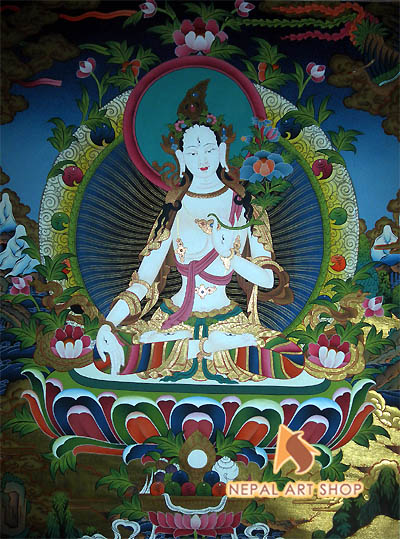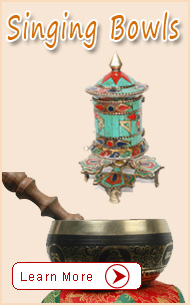


Thangka Paintings Gallery: Tibetan Thangka Painting Origin


Description
Tibetan thangka painting is an ancient art form that dates back to at least the 9th century. These paintings, which depict religious and spiritual figures, have a strong cultural and religious significance in Tibet and are still practiced today. In this essay, we will explore the history and origin of Tibetan thangka painting, as well as its symbolism and spiritual symbolism. The origin of Tibetan thangka painting is said to be traced back to the 8th and 9th centuries. During this period, Buddhism was being introduced to Tibet and Buddhist art was gaining popularity. Thangka paintings were used as a way to teach and explain Buddhist concepts to the people of Tibet. The art form was also used to spread the teachings and stories of Buddhism, to promote the faith and to pass on spiritual knowledge. The traditional thangka painting style is characterized by its vibrant colors, intricate details, and symbolic imagery. The imagery often includes a central figure, typically a Buddha, surrounded by symbols and motifs that represent teachings or spiritual concepts. These symbols may include lotuses, stupas, and mandalas, as well as animals, such as dragons and snow lions. All of these symbols are used to convey spiritual messages and meanings.
Thangka paintings are usually made with paints derived from natural minerals and stones, such as lapis lazuli, malachite, and cinnabar. The paintings are usually done on a cotton or silk canvas, and they are often framed in gold or other precious metals. Although the painting style is ancient, it is still practiced today in Tibet and other parts of Asia. Thangka paintings are considered sacred objects and are used for religious ceremonies and rituals. They are also used for decorative purposes, and they can be found in many homes and temples across Tibet. The symbolism of Tibetan thangka paintings is deeply rooted in Buddhism and Tibetan culture. The symbols and motifs used in thangka paintings are said to represent Buddhist teachings, such as the Four Noble Truths, the Eightfold Path, and the Three Jewels. The paintings also often depict spiritual figures, such as the Buddha, bodhisattvas, and deities, which are said to bring blessings and protection to those who view them.
In summary, Tibetan thangka painting is an ancient art form that dates back to the 8th and 9th centuries. The paintings are traditionally made with natural minerals and stones and are used to teach and explain Buddhist concepts. The symbolism of thangka paintings is deeply rooted in Buddhism and Tibetan culture, and the paintings are still used today for religious ceremonies and decorative purposes.
For Tibetan Thangka Painting Price-Shipping Cost- deal done please email us.
Email: nepalartshop@gmail.com | Whatsapp: 977 9860937940
Tibetan thangka painting is an ancient art form that dates back to at least the 9th century. These paintings, which depict religious and spiritual figures, have a strong cultural and religious significance in Tibet and are still practiced today. In this essay, we will explore the history and origin of Tibetan thangka painting, as well as its symbolism and spiritual symbolism. The origin of Tibetan thangka painting is said to be traced back to the 8th and 9th centuries. During this period, Buddhism was being introduced to Tibet and Buddhist art was gaining popularity. Thangka paintings were used as a way to teach and explain Buddhist concepts to the people of Tibet. The art form was also used to spread the teachings and stories of Buddhism, to promote the faith and to pass on spiritual knowledge. The traditional thangka painting style is characterized by its vibrant colors, intricate details, and symbolic imagery. The imagery often includes a central figure, typically a Buddha, surrounded by symbols and motifs that represent teachings or spiritual concepts. These symbols may include lotuses, stupas, and mandalas, as well as animals, such as dragons and snow lions. All of these symbols are used to convey spiritual messages and meanings.
Thangka paintings are usually made with paints derived from natural minerals and stones, such as lapis lazuli, malachite, and cinnabar. The paintings are usually done on a cotton or silk canvas, and they are often framed in gold or other precious metals. Although the painting style is ancient, it is still practiced today in Tibet and other parts of Asia. Thangka paintings are considered sacred objects and are used for religious ceremonies and rituals. They are also used for decorative purposes, and they can be found in many homes and temples across Tibet. The symbolism of Tibetan thangka paintings is deeply rooted in Buddhism and Tibetan culture. The symbols and motifs used in thangka paintings are said to represent Buddhist teachings, such as the Four Noble Truths, the Eightfold Path, and the Three Jewels. The paintings also often depict spiritual figures, such as the Buddha, bodhisattvas, and deities, which are said to bring blessings and protection to those who view them.
In summary, Tibetan thangka painting is an ancient art form that dates back to the 8th and 9th centuries. The paintings are traditionally made with natural minerals and stones and are used to teach and explain Buddhist concepts. The symbolism of thangka paintings is deeply rooted in Buddhism and Tibetan culture, and the paintings are still used today for religious ceremonies and decorative purposes.
For Tibetan Thangka Painting Price-Shipping Cost- deal done please email us.
Email: nepalartshop@gmail.com | Whatsapp: 977 9860937940
- Cras dictum. Maecenas ut turpis. In vitae erat ac orci dignissim eleifend.
- Pellentesque habitant morbi tristique senectus et netus et malesuada fames ac turpis egestas.
- Nunc quis justo. Sed vel ipsum in purus tincidunt pharetra.
- Nunc quis justo. Sed vel ipsum in purus tincidunt pharetra.

















